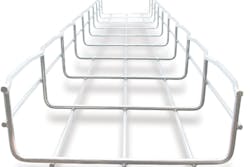Under the new Food Safety Modernization Act (FSMA), food and beverage processing facilities must commit to tighter safety controls, greater documentation and continuous safety improvement across their entire enterprise. These guidelines are causing many facilities to not only meet the standards, but also to implement new systems that exceed expectations in maintenance, performance and safety.
The challenge for many in the industry, however, is that there are more old plants than newer ones. This is a key pressure point for plant and facility managers who need to make ongoing improvements to food safety in their facilities, whether old or new.
When outfitting or installing a new system, there are two primary cable management options: the traditional conduit system and an open cable tray system. Opting for a wire mesh cable tray over a conduit system offers many performance advantages — namely easier installation, simpler maintenance and, perhaps most important, increased food safety.
An easier way to stay safe
When it comes to cable management systems, many food and beverage processors look for a manageable solution that promises continued safety. However, this priority might lead some to automatically turn to stainless steel or antimicrobial conduit, which is significantly more expensive and still prone to potentially contaminating an entire system.
When it comes to preventing contamination, conduit can cause a host of problems for a food and beverage processing plant. Conduit systems draw in moist air where it is trapped and condenses. An open cable tray wiring system provides highly desirable safety features not offered by conduit. The cable tray is not an enclosed system — the wire is completely exposed, yet safely secured in the tray — removing the opportunity for moisture condensation and accumulation to occur.
Because of this, wire mesh cable tray is ideal for the food and beverage industry. There is no danger in exposing the cable wires. In fact, keeping them enclosed in a conduit can further spread contamination through water ingress. Due to frequent washdowns — which are required to ensure system cleanliness — a closed system is susceptible to bacterial growth, as water can get stuck in the conduit and fittings. This can lead to cable deterioration and potentially a bacterial contamination, which would entirely shut down a facility and potentially spread to the products.
The wire mesh in a cable tray management system is passivated, removing all contamination potential from processing. Plus, the open system doesn’t allow contamination to move outside the enclosure — unlike a conduit system, which could essentially deliver bacteria throughout the facility on a fast track.
Besides, wire mesh is also made of the same stainless steel in certain conduit systems — but at a fraction of the cost.
Wire mesh cable tray is made of passivated stainless steel, making it corrosion-resistant, durable and three times more resistant to chlorine.
Fewer headaches up front
A visual comparison between a conduit and cable tray system reveals which one is simpler. One is a highly coordinated system of concentric bends, with each conduit individually bent, sorted, mounted and arranged with cables. The other is an open, accessible layout, while still providing an organized solution.
Because of its extensive bends and complex routes, a closed conduit system involves an intensive installation process — one that requires a high level of skill and plenty of time to complete. Finding a technician with experience bending conduit may be difficult in itself.
On the other hand, an open system of wire mesh requires significantly less time to install. A wire mesh cable tray can be installed quickly, easily and without the need for costly labor. Plus, cables run neatly throughout the system without the headache of creating a piece of conduit for each one.
An open system installation is also significantly more cost-effective, as it costs up to 40 percent less than a conduit job. If stainless steel or antimicrobial conduit is required — possibly due to corrosion or cleanliness concerns — the cost can be even higher. Plus, wire mesh cable can be installed at a fraction of the price, and even more can be saved due to the reduction in labor.
Simplify the long term
Once the system is installed, there are still significant differences in overall upkeep to consider.
Take cable replacement, for example. It is a routine part of the system’s maintenance, but it can feel like anything but routine when it comes to a conduit system. It doesn’t easily open, can’t be easily moved and doesn’t disassemble easily. Plus, to work in new machinery, the power may need to be shut off entirely, the conduit itself may need to be rebended and it will require even more labor to adjust the system.
In an open system of wire mesh cable pathway, adjustments and repairs can be made with minimal downtime. In fact, modifications to open systems take about five to 10 minutes. Power can run uninterrupted while a system is worked on, and there is no rebending required. Simply put, if a cable is faulty the end user can just reach in and repair or remove it.
Recipe for success
Replacing conduit with cable trays represents a significant opportunity — especially for processors looking for new ways to further improve facility safety in accordance with FSMA.
Choosing a cable management system for a food and beverage facility can be difficult, and it’s tempting to stick with the tried-and-true method of conduit. However, wire mesh is an ideal option for cable management in this processing industry. Its rigorous safety standards and features, coupled with a cost-effective and flexible system, make it more ideal for many food and beverage applications.

